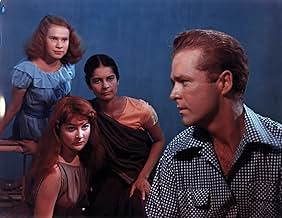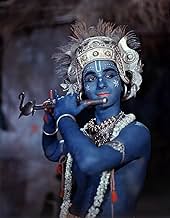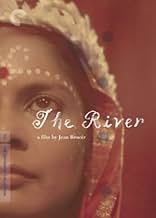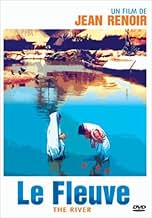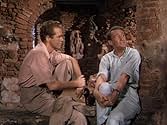VALUTAZIONE IMDb
7,4/10
7227
LA TUA VALUTAZIONE
I crescenti problemi e dolori di tre giovani donne in contrasto con l'immutabilità del sacro fiume del Bengal, attorno al quale le loro vite prendono forma.I crescenti problemi e dolori di tre giovani donne in contrasto con l'immutabilità del sacro fiume del Bengal, attorno al quale le loro vite prendono forma.I crescenti problemi e dolori di tre giovani donne in contrasto con l'immutabilità del sacro fiume del Bengal, attorno al quale le loro vite prendono forma.
- Nominato ai 2 BAFTA Award
- 3 vittorie e 4 candidature totali
June Tripp
- Narrator
- (voce)
- (as June Hillman)
Nimai Barik
- Kanu
- (non citato nei titoli originali)
Richard R. Foster
- Bogey
- (non citato nei titoli originali)
Jane Harris
- Muffie
- (non citato nei titoli originali)
Jennifer Harris
- Mouse
- (non citato nei titoli originali)
Trilak Jetley
- Anil
- (non citato nei titoli originali)
Sajjan Singh
- Ram Singh - The Gateman
- (non citato nei titoli originali)
Penelope Wilkinson
- Elizabeth
- (non citato nei titoli originali)
Cecilia Wood
- Victoria
- (non citato nei titoli originali)
Recensioni in evidenza
10ELSPENCE
I believe that both Karina and Gabridl are slightly off when they say that the film is supposed to depict post-independence India. I don't believe this is true and, therefore, Renoir cannot be taken to task for not covering India's independence struggles. Although the film was made post-independence (1951), it does not cover the period of independence itself (late 1930s to actual independence in 1947). Remember, that the film is a "memory film" and is based on the autobiography of Rumer Godden, who was born in 1907. The adult narrator is a grown-up Harriet. A grown-up Harriet in 1951 would be speaking of an earlier time--probably sometime in the 1920s--that was a more peaceful time for the English colonial inhabitants. The clothing and hairstyles can't be used to indicate when the film takes place. Harriet's blue sack of a dress would have been worn by any 13 year-old girl from the 1920 through the 1940s. And Valerie's rather unkempt and flowing hair could be anytime, too.
As for Melanie having an Indian accent. I don't believe that it was ever said that Melanie was educated in England. I believe that the film says she was educated in a convent, and there were certainly convent schools in India in the 1920s. I find it interesting that when it is said that Melanie will probably marry Anil, an understanding that they have had since childhood, she is still wearing her convent uniform. When she develops a crush on Captain John, she starts to wear saris, maybe hoping to attract him through the exotic.
All in all, a beautiful, lyrical film that should not be missed.
As for Melanie having an Indian accent. I don't believe that it was ever said that Melanie was educated in England. I believe that the film says she was educated in a convent, and there were certainly convent schools in India in the 1920s. I find it interesting that when it is said that Melanie will probably marry Anil, an understanding that they have had since childhood, she is still wearing her convent uniform. When she develops a crush on Captain John, she starts to wear saris, maybe hoping to attract him through the exotic.
All in all, a beautiful, lyrical film that should not be missed.
A really glorious, spellbinding movie. Filmed in Bengal, India, on the Ganges, it captures the essence of India, the timeless quality of life on the Ganges, without being patronizing.
This is a coming of age movie about three teenage girls, two British and one Anglo-Indian, and how their lives are affected by the arrival of a one-legged American war veteran. It's very easy to fall into sentimentality in a movie like this, but Renoir avoids this obvious pitfall. Though I have to say, I found this film very moving.
It helps that this movie is filmed in Technicolor, and is one of the best uses of Technicolor of that era.
Some of the performers were amateurs, including the actor who played the veteran and some of the children, but overall the performances are outstanding. A fine, low-key performance by Esmond Knight. This was the only film for Patricia Walters, who played Harriet, and Thomas Breen, the war veteran who played Captain Jack, never made any other movies. Watch for Arthur Shields, the brilliant Irish actor, as father of Nan.
This is a coming of age movie about three teenage girls, two British and one Anglo-Indian, and how their lives are affected by the arrival of a one-legged American war veteran. It's very easy to fall into sentimentality in a movie like this, but Renoir avoids this obvious pitfall. Though I have to say, I found this film very moving.
It helps that this movie is filmed in Technicolor, and is one of the best uses of Technicolor of that era.
Some of the performers were amateurs, including the actor who played the veteran and some of the children, but overall the performances are outstanding. A fine, low-key performance by Esmond Knight. This was the only film for Patricia Walters, who played Harriet, and Thomas Breen, the war veteran who played Captain Jack, never made any other movies. Watch for Arthur Shields, the brilliant Irish actor, as father of Nan.
India has, through the years, fascinated many a major film-maker, including Robert Flaherty, Fritz Lang, Louis Malle, Michael Powell, Roberto Rossellini and Jean Renoir. Renoir's film, based on a novel by English novelist Rumer Godden of BLACK NARCISSUS (1947) fame, is as gorgeously shot (in ravishing Technicolor) as can be expected from a master film-maker and the son of a famous French impressionist painter; however, the narrative itself is rather disappointingly thin to support its 99-minute running time. Having said that, the coming-of-age story of two English girls living in India and loving the same young officer wounded in WWII, is appealingly performed by Nora Swinburne, Esmond Knight, Arthur Shields and Adrienne Corri. The central character, played winningly by newcomer Patricia Walters (whose only film this turned out to be) is a stand-in for Godden herself, whose considerable writing talent was not encouraged by her stern family. The film offers Renoir another chance to show his humanist side dwelling as it does on the strange (to Western eyes) social and religious customs of the Indian people; even so, when all is said and done, there is just too much local color in the film. However, as Renoir is not only one of my favorite film directors but arguably the greatest of all French film-makers, I am confident that a second viewing of THE RIVER will elevate significantly my estimation of it, as it is probably too rich an experience to savor all at one go.
Among the copious supplements on the Criterion DVD, there is a typically enthusiastic interview with Martin Scorsese (who also helped in funding the film's restoration) who waxes lyrically on the effect the film had on him as a 9 year-old film-goer; surprisingly for me, he also confesses that the appeal of Renoir's masterpiece, LA REGLE DU JEU (1939), an automatic candidate for the title of the greatest film of all time, escapes him!!
Among the copious supplements on the Criterion DVD, there is a typically enthusiastic interview with Martin Scorsese (who also helped in funding the film's restoration) who waxes lyrically on the effect the film had on him as a 9 year-old film-goer; surprisingly for me, he also confesses that the appeal of Renoir's masterpiece, LA REGLE DU JEU (1939), an automatic candidate for the title of the greatest film of all time, escapes him!!
Jean Renoir embraces Technicolor for the first time in his adaptation of Rumer Godden's coming- of-age novel THE RIVER, with the latter collaborating on the screenplay. The story takes place in Bengal, India, a teenage girl named Harriet (Walters) is the eldest child of a middle-class British family living near the riverbank of Ganges, her father (an one-eyed Knight) runs a jute mill, and her mother (Swinburne) is expecting a child no. 7.
It is a carefree scenario, growing up in the natural inculcation of an exotically profound Hindu culture while carrying on an genteel upbringing, sometimes, it conspires to be a false or at least parochial impression of the land and its people, which doesn't take up too much space in the story-line, the only native Indian who has a speaking part is Nan (Mukerjee), the family's convivial but gossipy nanny, and the rest sustains as an ethnic curiosity to meet the Westerners' eyes, although beguilingly and entrancingly so, after all, what we are allowed to watch is the smugly colonial tip of the Indian iceberg.
The plot revolves around Harriet's budding affection towards the guest of their neighbor Mr. John (Shields), an one-legged American Captain John (Breen), who takes his time in lolling on a foreign land, to find some peace with his battlefield past and physical disability, look for a new resolution for life. As John is the only eligible white young man on the market, to her chagrin, a besotted, but fairly plain-looking Harriet has a losing game against her rival, the maturer and more zaftig Valerie (Corri), by the way, a British girl too is also her best friend. And throughout this picturesque film, it is Harriet's voice-over that guides viewers traversing her prepubescent triviality (poems, indeed), to listen to her inner voice, to sympathize her unrequited love, to find empathy in this garden-variety tale.
Wielded as an emotional clincher, a tragic incident materializes as one downside of having a brood of many caused by adult negligence, but here also emanates a disquieting undertow to pinpoint the virulence of a foreign society with a local boy standing by as an unwary abetter. And a cheesy solution to get it over is taking the pro-procreation flag, babies are being borne all the time.
The cast is mixed with adult professionals and amateur players, but comes off barely adequate, a major gripe is the narrative ellipsis in the story of Melanie (Radha), the mixed-race daughter of Mr. John, who stands out (there is not much competition though) with a massively pleasurable Ganesha-courting dancing sequence, but whose dislike of herself, waffling identity never been considerably mapped out as a pre-eminent counterpoint of Harriet's more orthodox background.
So, all above sounds like a pejorative critique against a film who has earned a hallowed reputation since its genesis, yet, it is as plain as the nose on one's face, the picture's eye-catching glamour and aural accompaniments are undeniably supreme, technologically speaking. And it is smart enough for Mr. Renoir to treat it as a philosophical prose other than a heady narration of banal proceedings, only a 60-odd-year later, its allure fades away slightly due to the original novel's awkward stance on a colonized land and Renoir's condoning deference.
It is a carefree scenario, growing up in the natural inculcation of an exotically profound Hindu culture while carrying on an genteel upbringing, sometimes, it conspires to be a false or at least parochial impression of the land and its people, which doesn't take up too much space in the story-line, the only native Indian who has a speaking part is Nan (Mukerjee), the family's convivial but gossipy nanny, and the rest sustains as an ethnic curiosity to meet the Westerners' eyes, although beguilingly and entrancingly so, after all, what we are allowed to watch is the smugly colonial tip of the Indian iceberg.
The plot revolves around Harriet's budding affection towards the guest of their neighbor Mr. John (Shields), an one-legged American Captain John (Breen), who takes his time in lolling on a foreign land, to find some peace with his battlefield past and physical disability, look for a new resolution for life. As John is the only eligible white young man on the market, to her chagrin, a besotted, but fairly plain-looking Harriet has a losing game against her rival, the maturer and more zaftig Valerie (Corri), by the way, a British girl too is also her best friend. And throughout this picturesque film, it is Harriet's voice-over that guides viewers traversing her prepubescent triviality (poems, indeed), to listen to her inner voice, to sympathize her unrequited love, to find empathy in this garden-variety tale.
Wielded as an emotional clincher, a tragic incident materializes as one downside of having a brood of many caused by adult negligence, but here also emanates a disquieting undertow to pinpoint the virulence of a foreign society with a local boy standing by as an unwary abetter. And a cheesy solution to get it over is taking the pro-procreation flag, babies are being borne all the time.
The cast is mixed with adult professionals and amateur players, but comes off barely adequate, a major gripe is the narrative ellipsis in the story of Melanie (Radha), the mixed-race daughter of Mr. John, who stands out (there is not much competition though) with a massively pleasurable Ganesha-courting dancing sequence, but whose dislike of herself, waffling identity never been considerably mapped out as a pre-eminent counterpoint of Harriet's more orthodox background.
So, all above sounds like a pejorative critique against a film who has earned a hallowed reputation since its genesis, yet, it is as plain as the nose on one's face, the picture's eye-catching glamour and aural accompaniments are undeniably supreme, technologically speaking. And it is smart enough for Mr. Renoir to treat it as a philosophical prose other than a heady narration of banal proceedings, only a 60-odd-year later, its allure fades away slightly due to the original novel's awkward stance on a colonized land and Renoir's condoning deference.
10Fesch
This is one of those rare films which give you the impression after viewing it that you have truly lived and shared the lives of its characters (not just 'two people received that kiss', as they say in the film, but everyone who's watching the movie).
You became part of that river as the film progresses, it is perhaps the picture which has described the passage of time better than any other. It is life, running within its waters, that catches your soul, which melts with the river and the film and your memory...
I think it is the only movie that made me run to a bookstore to buy the book it was based on. Rumer Godden's work is beautiful indeed, but the film is far better for me.
Highly recommended!
You became part of that river as the film progresses, it is perhaps the picture which has described the passage of time better than any other. It is life, running within its waters, that catches your soul, which melts with the river and the film and your memory...
I think it is the only movie that made me run to a bookstore to buy the book it was based on. Rumer Godden's work is beautiful indeed, but the film is far better for me.
Highly recommended!
Lo sapevi?
- QuizThomas E. Breen, who plays Capt. John, was really missing one leg like his character.
- Blooper(at around 36 mins) A cigarette appears from nowhere.
- ConnessioniFeatured in Lontano (2001)
I più visti
Accedi per valutare e creare un elenco di titoli salvati per ottenere consigli personalizzati
- How long is The River?Powered by Alexa
Dettagli
- Data di uscita
- Paesi di origine
- Sito ufficiale
- Lingue
- Celebre anche come
- Río sagrado
- Luoghi delle riprese
- Azienda produttrice
- Vedi altri crediti dell’azienda su IMDbPro
Botteghino
- Lordo in tutto il mondo
- 53.357 USD
- Tempo di esecuzione
- 1h 39min(99 min)
- Proporzioni
- 1.37 : 1
Contribuisci a questa pagina
Suggerisci una modifica o aggiungi i contenuti mancanti


